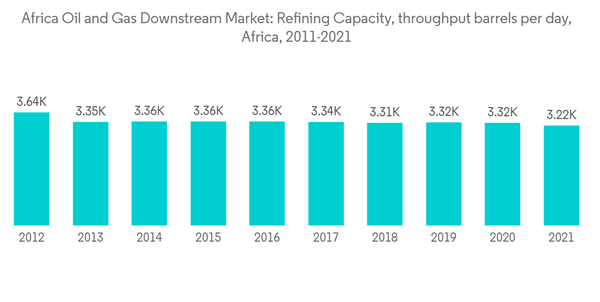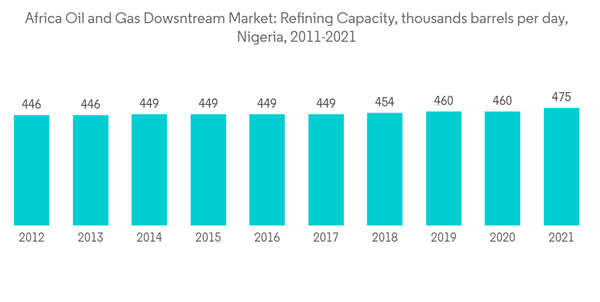COVID-19 negatively impacted the market in 2020. Presently the market has now reached pre-pandemic levels.
Key Highlights
- Over the medium term, Africa's downstream market is increasing due to the economy's growth, and aiding the development and expansion of refined petroleum complexes are expected to drive the growth of the market studied.
- On the other hand, instability in the government of various African nations and militant attacks on oil and gas activities discourage foreign investments and are expected to hamper the growth of the African oil and gas downstream market during the forecast period.
- Nevertheless, Africa is one of the most underdeveloped natural resource-rich regions, making it open to the upstream oil and gas market development. Directly aiding the downstream demand will likely create lucrative growth opportunities for the African oil and gas downstream market in the forecast period.
- Nigeria is to witness significant growth and is also likely to witness the highest CAGR during the forecast period. This growth is attributed to the increasing investments, coupled with the forefront of downstream infrastructure development in the country.
Africa Oil & Gas Downstream Market Trends
Refining Sector to Dominate the Market
- In Africa, upstream oil and gas activities are increasing to meet the domestic demand for hydrocarbons in the nation, directly aiding the downstream market. In addition, the rapid industrial and commercial market is growing in Africa on a quick sale, helping the demand for petrol, diesel, and refined petrochemical.
- As per BP Annual Statistical Review of World Energy 2022 statistics, Africa's refining capacity was 3,219 throughput barrels per day in 2021. The increasing refining capacity in the African region is expected to drive the African oil and gas downstream market.
- According to the Internation Energy Agency, Africa's overall energy consumption is expected to double as the population and economies grow in the next decade. African countries are investing in downstream markets to meet this demand.
- In addition, as of 2021, the Nigeria Federal Government planned to establish 18 refineries in the country’s six oil-producing states in the Niger Delta, including Rivers, Bayelsa, Akwa Ibom, Delta, Edo, and Cross River.
- For instance, as of 2021, the Egyptian Ministry of Petroleum and Mineral Resources is investing USD 14 billion to construct five primary refining and petrochemical projects. Further, new petrochemical projects are being established to sustain the provision of petroleum and petrochemical products to the local market and the state's economic sectors and reduce the import bill.
- As of 2022, the Assiut Oil Refinery is under expansion and modernization to meet the growing demand for petroleum products in Assiut, Egypt. The expansion and modernization project will further increase the refining capacity of the existing refinery, which currently produces 4.5 million tonnes per annum (Mtpa) of distillation crude. The project is scheduled for completion by the end of 2022.
- Therefore, the growing demand and economic growth are expected to drive the segment in the coming years.
Nigeria to Witness Significant Growth
- The Nigerian oil and gas downstream involve refining, petrochemical, and retail petroleum sales. Refining is one of the significant segments in the sector. According to the BP Statistical Review of World Energy 2022, the refining capacity has increased at a relatively lower rate, from 446 thousand barrels per day in 2011 to about 475 thousand barrels per day in 2021.
- Since Nigeria is one of the largest oil producers in the region, the downstream industry is growing to increase the export of refined petroleum products to support the nation's economy and reduce reliance on imports for refined petroleum products.
- For instance, as of 2022, Dangote Refinery is under construction, which is expected to have a refining capacity of 650,000 barrels per day and is being developed in partnership with Nigerian National Petroleum Company Limited. (NNPC). Further, NNPC aims to stop refined petrochemical imports through this refinery. It is expected to be Africa’s biggest oil refinery and the world’s most extensive single-train facility upon completion in 2022.
- However, political instability and the smuggling of petrol are one of the ill effects on the country's downstream market development, reducing foreign players' interest in investing in the market.
- Overall, a growing economy and government support to reduce foreign reliance on petrochemical products would aid the downstream market in the country.
Africa Oil & Gas Downstream Market Competitor Analysis
The Africa Oil and Gas downstream market is moderately consolidated in nature. Some of the major players in the market (in no particular order) include Nigerian National Petroleum Company Limited, Egyptian General Petroleum Corporation, Shell PLC, ExxonMobil Corporation, and Midoil Refining & Petrochemicals Company Limited.Additional benefits of purchasing the report:
- The market estimate (ME) sheet in Excel format
- 3 months of analyst support
This product will be delivered within 2 business days.
Table of Contents
Companies Mentioned (Partial List)
A selection of companies mentioned in this report includes, but is not limited to:
- Nigerian National Petroleum Company Limited
- Egyptian General Petroleum Corporation
- Sinopec Shanghai Petrochemical Co., Ltd.
- ExxonMobil Corporation
- Midoil Refining & Petrochemicals Company Limited










